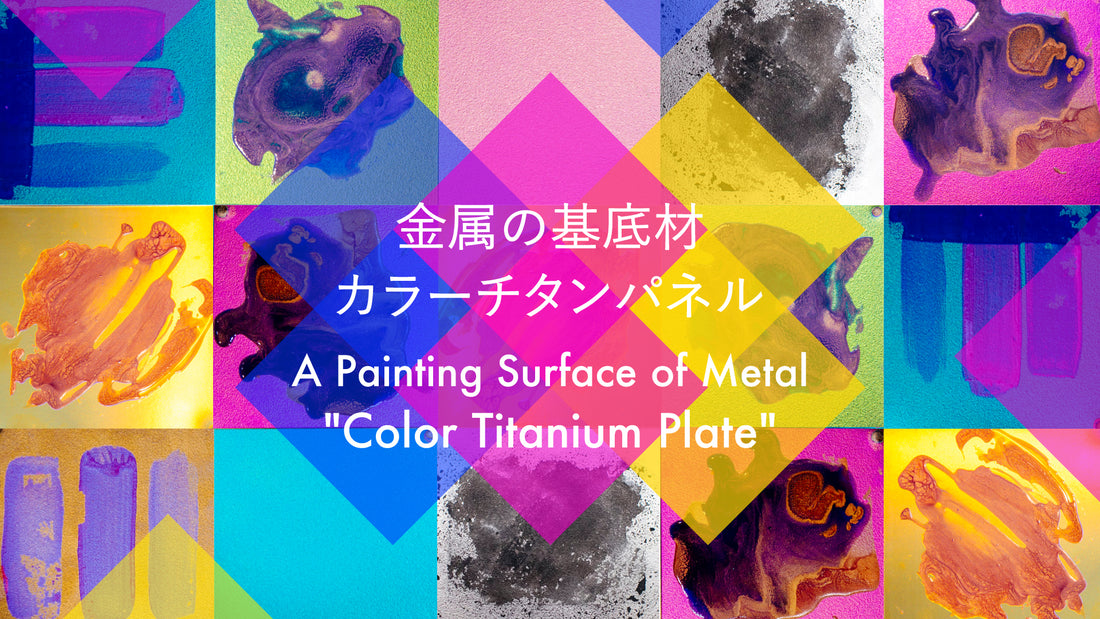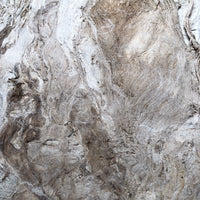Last Updated on : June 8th, 2024
Have you ever heard of a metal called titanium?
The painting substrates carried by PIGMENT TOKYO include not only commonly used materials like paper and canvas, but also titanium metal sheets.
TranTixxii® is a design-oriented titanium material developed by NIPPON STEEL CORPORATION. It has developed an unparalleled brand in the world that pursues beauty in titanium.
In this article, we feature the story behind the development of TranTixxii®.
【The Characteristics of Titanium】
・More durable than iron and aluminum.
・High corrosion resistance, semi-permanently rust-free.
・Hardly discolored by acid rain so often used for exterior walls, etc.
・Highly resistant to ultraviolet rays and seawater, as well as discoloration caused by acid rain, often use
d as the exterior of architecture.
【Features of TranTixxii®】
⚫︎Wide Color Variation
・Through TranTixxii’s proprietary technology, a huge range of colors can be produced by controlling the oxide film on the titanium surface.
・A wide variety of colors is available.
⚫︎Interference Colors
・Available in rich interference colors.
・The color changes depending on the viewing angle, weather, time and light condition.
⚫︎Light Weight
・Suitable weight for use as a painting substrate for artworks.
・High corrosion resistance.
・Resistant to rust and corrosion.
・Storable for long periods.
Please visit each product page for information on color variations and details.
*Some products are polarized.
*Please note that the polarized titanium may show different colors depending on the viewing angle and environment.
*Fingerprints adhere easily to the surface of the titanium, making them difficult to remove. Therefore, it is recommended to use gloves when working with the titanium sheets.
【Color Titanium Plates Used for Sample】
SD3 (Hard Color)
Texture: Glossy mirror finish
Size: Panel (titanium plate bonded to wooden panel) - F6 , F10, F15, F25
Sample - 100mm x 100mm
ND20 (Hard Color)
Texture: Matte finish with bumpy surface
Size: Panel (titanium plate bonded to wooden panel) - F6 , F10, F15, F25
Sample - 100mm x 100mm
Please click the link below to see all the products.
Color Titanium Panels
Fun fact, the wide variety of colors from the titanium is not created by paint.
When a thin oxide coating (colorless and transparent) is formed on the surface of titanium, the interference of light reveals colors and by varying the thickness of this coating, a wide range of colors is created.
TranTixxii® was developed by harnessing the advantages of titanium. As a metal product, it offers diverse possibilities and I’m very confident in its exceptional qualities as a material based on these features. However, I remain curious about how titanium can be utilized in the actual art practice.
Next, I plan to experiment with four different colored titanium sheets.
■Titanium Panels × Effect Pigments
Effect pigments are beautiful even as they are, but what kind of luminosity will they appear when they are applied to colored titanium panels?
Here is a Duo Chrome that polarizes in a subtle color.

【Art Materials Used】
■Image Left
Color Material: Duo Chrome RB
Medium: Acrylic emulsion
Substrate: Color Titanium Panel ND20 (#8)
■Image Right
Color Material: Duochrome RB/Kusakabe Cerulean Blue
Medium: Acrylic emulsion
Substrate: Color Titanium Panel ND20 (#76)
On both sides, paint is applied as below.
・Diluted with water
・Thick paint (plenty)
・Thick paint (dry)
Duo Chrome is a type of pearlescent pigment made from mica coated with titanium dioxide or iron oxide. It is an effect pigment with a polarizing character. For example, the Duo Chrome RB produces a pinkish glow when applied to a white background, while it emits a bluish glow on a black background. As a result, a slightly more reddish-pink pearlescent color appears in the #8 (gold type) titanium panel compared to the #76 (blue type) panel.
I also applied a layer of Kusakabe's Cerulean Blue to the #76 panel on the right. It's a little hard to tell from the image, but you can see a hint of Duo Chrome RB, so it’s better to adjust the way you paint and make good use of the background and paint effects.
I recognize the potential of the titanium panels for creating art pieces by taking advantage of the color, polarizing effect and unevenly textured surface. Moreover, varying the number of paint layers applied to the surface could lead to a greater range of effects.
Next, I painted the [Me] Victoria Red F120-5, a color that exudes a passionate atmosphere with shades of gold and orange. The titanium panel I used was the SD3 in #0 (silver) with a mirror finish.
This #0 panel does not have any interference effect because it has not been coated with any oxide films. The images below show the same object, but I've compared the differences in color appearance based on the viewing angle.

【Art Materials Used】
Substrate: Color Titanium Plate Sample SD3 (Hard Color) #8
Color Material: [Me] Victoria Red F120-51, Duo Chrome RB
Medium: Acrylic Emulsion
Substrate: Color Titanium Plate Sample SD3 (Hard Color) #0
Color Material: [Me] Victoria Red F120-51, Duo Chrome RB
Medium: Acrylic Emulsion
[Me] Victoria Red F120-51 is a paste-type photoluminescent pigment based on high-purity flake alumina, therefore, it has no polarizing effect by itself. Duo Chrome RB was also applied to see if there was a polarization effect.
The left image is exposed to the light from above, while the right image is taken from a slight angle.
This panel is more susceptible to ambient color and light reflections, so it is easier to see the changes in the Duo Chrome than in the ND20. The more tilt the angle is, the more reddish pink it appears.
The way the paint sits on the surface is also different between SD3 and ND20, so always remember to take a few tries beforehand. Depending on your painting style, you may need to make some adjustments for the medium and paint density, whether you decide to apply multiple layers or not
Titanium panels will hold acrylic paints, but they may peel off a little depending on the type of acrylic paint you use. I recommend using a Metal and Glass Primer to avoid such incidents.
■Titanium Panel × Sumi Ink

【Art Materials Used】
Substrate: Color Titanium Plate Sample ND20 (Hard Color) #0
Color Material : Daiwagaboku Akanegumo (Sumi Ink)
When I applied Sumi ink to the ND20 panel, which has uneven surfaces, the ink tended to repel due to the moisture.
I applied one coat of ink to the lighter areas and 3 to 4 coats to the darker parts near the center. After several applications, the Sumi ink eventually adhered to the panel. However, the ink would still come off if I lightly scratched it with a sharp object.
This means that some creativity will be needed for display and long-term storage, but it is, in fact, possible to use ink on these titanium panels.
■Titanium Panel × Pebeo (Oil-based Alkyd Resin Paint)

【Art Materials Used】
Substrate: Color Titanium Plate Sample ND20 (Hard Color) #58
Color Material: Oil-based Alkyd Resin Paints Pebeo
Prism Pearl Bioline No.25 , Prism Vermillion No.12
Substrate: Color Titanium Plate Sample ND20 (Hard Color) #88
Color Material: Oil-based alkyd resin paint Pebeo
Prism Pearl Bioline No.25, Prism Vermillion No.12
Vitreille Sky Blue No,36

【Art Materials Used】
Substrate: Color Titanium Plate Sample SD3(#48)
Color Material: Oil-based Alkyd Resin Paints Pebeo
Prism Vermillion No.12
Pebeo is an oil-based alkyd resin paint that is also highly unique as a painting material.
It is an oil-based solvent that can be painted on canvas, paper, glass and metal while giving a glossy finish.
Vitrail is a highly transparent paint while Prisme is opaque and produces a beehive effect as the paint dries. Both are oil-based, have glossy finishes and can be mixed interchangeably.
In this case, I used a painting knife and poured it straight from the bottle, so the color surface was quite thick, but the paint on both ND20 and SD3 dried in about half a day.
I moved the painted panels around but they seem to be fixed on it quite well without peeling off.
The painting materials introduced in this article are just a few examples. I hope you find them useful and spark new ideas for your future art-making.
As a painting substrate, the color titanium plates have a great potential to create a huge range of styles and expressions. So, how about trying it as a spice for your creativity?
This article features the story behind the development of TranTixxii®.
【ARTICLES】Development Story of TranTixxii®

NIPPON STEEL CORPORATION
The designing titanium, TranTixxii®
ENG https://www.nipponsteel.com/en/product/trantixxii/
Translated by Atsumi Okano, Nelson Hor Ee Herng
PIGMENT TOKYO Art Materials Experts















